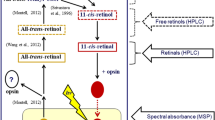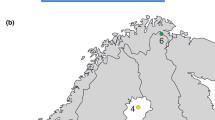Abstract
The ultrastructural state of the crayfish visual membrane is correlated with its fatty acid composition during times of photic and thermal stress and the period over which the dynamic events occur is investigated. Crayfish kept at 4 °C under constant darkness contain in their rhabdoms significantly increased amounts of unsaturated fatty acids such as 16:1, 18:1, 20:5, and 22:6 compared with individuals kept at 25 °C. The ratio of unsaturated/saturated fatty acids (UFA/SFA-ratio) amounts to 2.17 in the cold-water- and 1.46 in the warm water-acclimated animals. The visual membranes of crayfish suddenly transferred from 4 °C to 25 °C exhibited ultrastructural modifications such as membrane collapse and disappearance of microvillar dense␣core-filaments most clearly 3 h post-transfer. Parallel to the structural changes a significant increase in fatty acid 18:0 was observed, while the amounts of 16:1 and 20:1 decreased. When 4 °C, dark-adapted crayfish were exposed to light alone and not a temperature increase, only fatty acid 22:6 showed a significant reduction to 10% of its pre-experimental level within 2 h of exposure. Thereafter, it slowly increased again. In cold water-acclimated crayfish that had been exposed to light of 5000 lx for 3␣weeks no significant change of the UFA/SFA ratio was observed, although fatty acid species 18:0, 20:4, and 20:5 had increased at the expense of fatty acids 14:0, 16:0, 16:1, 18:1, 20:1, and 22:6. The total amount of fatty acids, however, had become significantly smaller (from 0.058 ng g−1 body weight in the dark-adapted to 0.048 ng g−1 in the light-adapted crayfish). Morphologically the rhabdom volume had decreased by approx. 20%, but ultrastructurally rhabdom microvilli remained almost unchanged. The amount of peroxidized lipids in the retina following irradiation with bright white light in the cold-adapted crayfish fell during the first 2 h of exposure from 0.4 nmol g−1 to 0.32 nmol g−1, but after 12 h of exposure had reached a level of 0.48 nmol g−1. Greatest structural abnormalities to the visual membranes occurred when dark-adapted, cold-acclimated crayfish were suddenly subjected to bright light and an increase in water temperature. Under such conditions the microvillar arrangement was disrupted and membrane collapse and disappearance of core-filaments were apparent. Our results provide evidence that the fatty acid composition of the membranes determines to a considerable extent the structural integrity of the photoreceptor, but that it is too simplistic a model to think that peroxidation of membrane lipids alone is responsible for the disintegration of the photoreceptive membranes in the crayfish eye following exposure to bright light.
Similar content being viewed by others
Author information
Authors and Affiliations
Additional information
Accepted: 4 July 1996
Rights and permissions
About this article
Cite this article
Kashiwagi, T., Meyer-Rochow, V., Nishimura, K. et al. Fatty acid composition and ultrastructure of photoreceptive membranes in the crayfish Procambarus clarkii under conditions of thermal and photic stress. J Comp Physiol B 167, 1–8 (1997). https://doi.org/10.1007/s003600050041
Issue Date:
DOI: https://doi.org/10.1007/s003600050041




